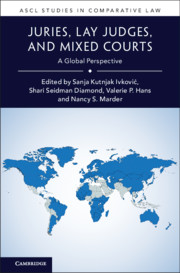Book contents
- ASCL Studies In Comparative Law
- Juries, Lay Judges, and Mixed Courts
- Copyright page
- Contents
- Editors
- Contributors
- Acknowledgments
- 1 Introduction
- Part I Advances in Lay Participation
- Part II Enduring Systems of Lay Participation
- Part III Challenges to Lay Participation in Law
- Part IV Global Perspectives on Lay Participation
- 14 What Hollywood, USA, Teaches the World (Incorrectly and Correctly) about Juries
- 15 The Case for a Hybrid Jury in Europe
- 16 A Worldwide Perspective on Lay Participation
- Name Index
- Subject Index
- References
16 - A Worldwide Perspective on Lay Participation
from Part IV - Global Perspectives on Lay Participation
Published online by Cambridge University Press: 03 August 2021
- ASCL Studies In Comparative Law
- Juries, Lay Judges, and Mixed Courts
- Copyright page
- Contents
- Editors
- Contributors
- Acknowledgments
- 1 Introduction
- Part I Advances in Lay Participation
- Part II Enduring Systems of Lay Participation
- Part III Challenges to Lay Participation in Law
- Part IV Global Perspectives on Lay Participation
- 14 What Hollywood, USA, Teaches the World (Incorrectly and Correctly) about Juries
- 15 The Case for a Hybrid Jury in Europe
- 16 A Worldwide Perspective on Lay Participation
- Name Index
- Subject Index
- References
Summary
This chapter provides a snapshot view of the different ways that 195 countries around the world use lay participation in legal decision-making. We collected information from a variety of sources, including new expert surveys, legal research, and existing empirical evidence, to determine which countries use lay citizens as legal decision-makers in criminal cases and how they use them. Approximately two-thirds of the world’s countries use some form of lay participation, and the most commonly used forms are juries and mixed tribunals. The use and form of lay participation vary by geography and by the legal tradition of the country. The majority of countries in Africa, Australia and Oceania, Europe, and North America use some form of lay participation in their legal systems. Countries with common-law or customary-law legal traditions are most likely to rely on lay citizens as legal decision-makers. The widespread use of lay participants around the globe underscores the importance of studying this phenomenon. This chapter provides a baseline against which future studies in lay participation can be measured.
Keywords
- Type
- Chapter
- Information
- Juries, Lay Judges, and Mixed CourtsA Global Perspective, pp. 323 - 345Publisher: Cambridge University PressPrint publication year: 2021

